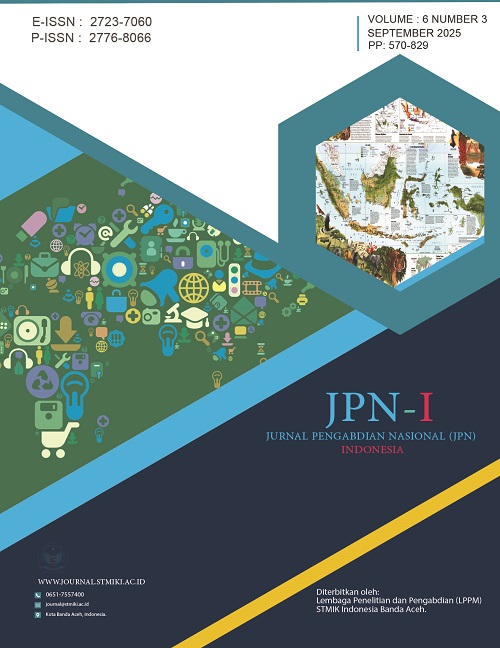Pengaruh Pelatihan Komunikasi terhadap Kompetensi Klinis Perawat dan Kepuasan Pasien di RS Pangkalpinang
Main Article Content
Abstract
Article Summary
This study aims to analyze the impact of communication training on nurses’ clinical competence and patient satisfaction at RS Pangkalpinang. Effective communication is a critical component in enhancing healthcare quality, particularly in nurse–patient interactions. A quantitative approach with a survey method was employed, involving 53 nurses who had completed structured communication training and 25 patients treated by those nurses. Data were analyzed using simple and multiple linear regression with SPSS version 26. The results showed a significant improvement in nurses’ clinical competence, with mean scores increasing from 72.4 (pre-test) to 85.7 (post-test), particularly in the domain of therapeutic communication. Patient satisfaction scores also increased from an average of 78.2 to 88.9 after the training intervention. Regression analysis revealed that communication training had a significant positive effect on nurses’ clinical competence (R² = 0.48; p < 0.001) and on patient satisfaction (R² = 0.41; p < 0.01). These findings suggest that structured communication training grounded in theoretical models such as Peplau’s Interpersonal Theory and the Calgary-Cambridge Guide can enhance professional competence and improve patient perceptions of care. The practical implication is that hospitals should integrate communication training into ongoing staff development programs and consider its replication in other healthcare settings to improve the overall quality of nursing services.
Downloads
Article Details

This work is licensed under a Creative Commons Attribution-NonCommercial-ShareAlike 4.0 International License.
References
Benner, P. (1984). From novice to expert excellence and power in clinical nursing practice. AJN The American Journal of Nursing, 84(12), 1479.
DeVito, J. A., & DeVito, J. (2019). The interpersonal communication book. Instructor, 1(18), 521-532.
Hendriana, H., Rohaeti, E. E., & Sumarmo, U. (2017). Hard skills dan soft skills matematik siswa. Bandung: Refika Aditama, 7, 2017.
Hidayat, D., Christin, M., & Nur’aeni, N. (2022). Teori komunikasi. Simbiosa Rekatama Media.
Komara, E., Syaodih, E., & Andriani, R. (2022). Metode penelitian kualitatif dan kuantitatif.
Kuantitatif, P. P. (2016). Metode penelitian kunatitatif kualitatif dan R&D. Alfabeta, Bandung.
Mulyawan, A., & Rinawati, R. (2017). Pengaruh Kualitas Layanan Akademik Terhadap Kepuasan Mahasiswa Serta Implikasinya Pada Loyalitas Mahasiswa (Studi Pada Sekolah Tinggi Manajemen Informatika Dan Komputer Di Kota Bandung). Jurnal Ekonomi, Bisnis & Entrepreneurship, 10(2), 119-131.
Nurachman, M. T. (2022). Pengaruh Komunikasi Efektif Terhadap Kejadian Tidak Diharapkan (KTD). Jurnal Cerebellum, 8(2), 12-15. https://doi.org/10.26418/jc.v8i2.54151.
Otani, K., Waterman, B., Faulkner, K. M., Boslaugh, S., Burroughs, T. E., & Dunagan, C. W. (2009). Patient satisfaction: focusing on “excellent”. Journal of healthcare management, 54(2), 93-102.
Parasuraman, A. B. L. L., Zeithaml, V. A., & Berry, L. (1988). SERVQUAL: A multiple-item scale for measuring consumer perceptions of service quality. 1988, 64(1), 12-40.
Peplau, H. E. (1952). Interpersonal relations in nursing. AJN The American Journal of Nursing, 52(6), 765.
Rohendi, A. (2019). The Service Management Triangle. Service Management Triangle: Jurnal Manajemen Jasa, 1(1).
Sarfika, R., Maisa, E. A., Yuliharni, S., Putri, D. E., Erwina, I., Wenny, B. P., ... & Novrianda, D. (2020). Pelatihan komunikasi terapeutik guna meningkatkan pengetahuan perawat dalam caring. Jurnal Hilirisasi IPTEKS, 3(1), 79-87. https://doi.org/10.25077/jhi.v3i2.386.
West, R. L., Turner, L. H., & Zhao, G. (2010). Introducing communication theory: Analysis and application (Vol. 2). New York, NY: McGraw-Hill.
World Health Organization. (2022). Health literacy development for the prevention and control of noncommunicable diseases: volume 2. A globally relevant perspective. World Health Organization.

